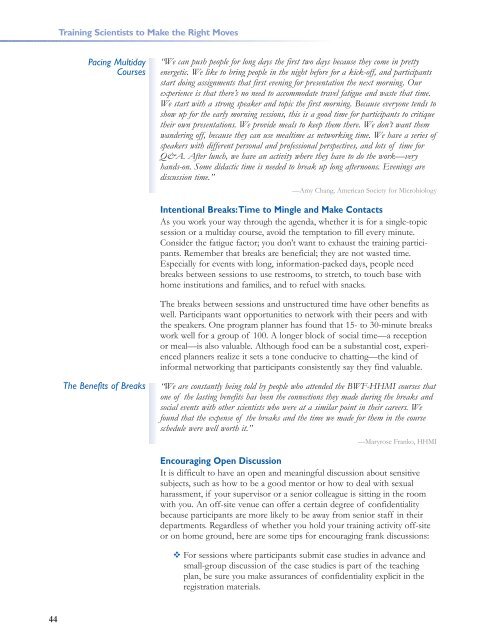Training Scientists to Make the Right Moves - Howard Hughes ...
Training Scientists to Make the Right Moves - Howard Hughes ...
Training Scientists to Make the Right Moves - Howard Hughes ...
You also want an ePaper? Increase the reach of your titles
YUMPU automatically turns print PDFs into web optimized ePapers that Google loves.
<strong>Training</strong> <strong>Scientists</strong> <strong>to</strong> <strong>Make</strong> <strong>the</strong> <strong>Right</strong> <strong>Moves</strong><br />
Pacing Multiday<br />
Courses<br />
“We can push people for long days <strong>the</strong> first two days because <strong>the</strong>y come in pretty<br />
energetic. We like <strong>to</strong> bring people in <strong>the</strong> night before for a kick-off, and participants<br />
start doing assignments that first evening for presentation <strong>the</strong> next morning. Our<br />
experience is that <strong>the</strong>re’s no need <strong>to</strong> accommodate travel fatigue and waste that time.<br />
We start with a strong speaker and <strong>to</strong>pic <strong>the</strong> first morning. Because everyone tends <strong>to</strong><br />
show up for <strong>the</strong> early morning sessions, this is a good time for participants <strong>to</strong> critique<br />
<strong>the</strong>ir own presentations. We provide meals <strong>to</strong> keep <strong>the</strong>m <strong>the</strong>re. We don’t want <strong>the</strong>m<br />
wandering off, because <strong>the</strong>y can use mealtime as networking time. We have a series of<br />
speakers with different personal and professional perspectives, and lots of time for<br />
Q&A. After lunch, we have an activity where <strong>the</strong>y have <strong>to</strong> do <strong>the</strong> work—very<br />
hands-on. Some didactic time is needed <strong>to</strong> break up long afternoons. Evenings are<br />
discussion time.”<br />
—Amy Chang, American Society for Microbiology<br />
Intentional Breaks:Time <strong>to</strong> Mingle and <strong>Make</strong> Contacts<br />
As you work your way through <strong>the</strong> agenda, whe<strong>the</strong>r it is for a single-<strong>to</strong>pic<br />
session or a multiday course, avoid <strong>the</strong> temptation <strong>to</strong> fill every minute.<br />
Consider <strong>the</strong> fatigue fac<strong>to</strong>r; you don’t want <strong>to</strong> exhaust <strong>the</strong> training participants.<br />
Remember that breaks are beneficial; <strong>the</strong>y are not wasted time.<br />
Especially for events with long, information-packed days, people need<br />
breaks between sessions <strong>to</strong> use restrooms, <strong>to</strong> stretch, <strong>to</strong> <strong>to</strong>uch base with<br />
home institutions and families, and <strong>to</strong> refuel with snacks.<br />
The breaks between sessions and unstructured time have o<strong>the</strong>r benefits as<br />
well. Participants want opportunities <strong>to</strong> network with <strong>the</strong>ir peers and with<br />
<strong>the</strong> speakers. One program planner has found that 15- <strong>to</strong> 30-minute breaks<br />
work well for a group of 100. A longer block of social time—a reception<br />
or meal—is also valuable. Although food can be a substantial cost, experienced<br />
planners realize it sets a <strong>to</strong>ne conducive <strong>to</strong> chatting—<strong>the</strong> kind of<br />
informal networking that participants consistently say <strong>the</strong>y find valuable.<br />
The Benefits of Breaks<br />
“We are constantly being <strong>to</strong>ld by people who attended <strong>the</strong> BWF-HHMI courses that<br />
one of <strong>the</strong> lasting benefits has been <strong>the</strong> connections <strong>the</strong>y made during <strong>the</strong> breaks and<br />
social events with o<strong>the</strong>r scientists who were at a similar point in <strong>the</strong>ir careers. We<br />
found that <strong>the</strong> expense of <strong>the</strong> breaks and <strong>the</strong> time we made for <strong>the</strong>m in <strong>the</strong> course<br />
schedule were well worth it.”<br />
—Maryrose Franko, HHMI<br />
Encouraging Open Discussion<br />
It is difficult <strong>to</strong> have an open and meaningful discussion about sensitive<br />
subjects, such as how <strong>to</strong> be a good men<strong>to</strong>r or how <strong>to</strong> deal with sexual<br />
harassment, if your supervisor or a senior colleague is sitting in <strong>the</strong> room<br />
with you. An off-site venue can offer a certain degree of confidentiality<br />
because participants are more likely <strong>to</strong> be away from senior staff in <strong>the</strong>ir<br />
departments. Regardless of whe<strong>the</strong>r you hold your training activity off-site<br />
or on home ground, here are some tips for encouraging frank discussions:<br />
For sessions where participants submit case studies in advance and<br />
small-group discussion of <strong>the</strong> case studies is part of <strong>the</strong> teaching<br />
plan, be sure you make assurances of confidentiality explicit in <strong>the</strong><br />
registration materials.<br />
44
















